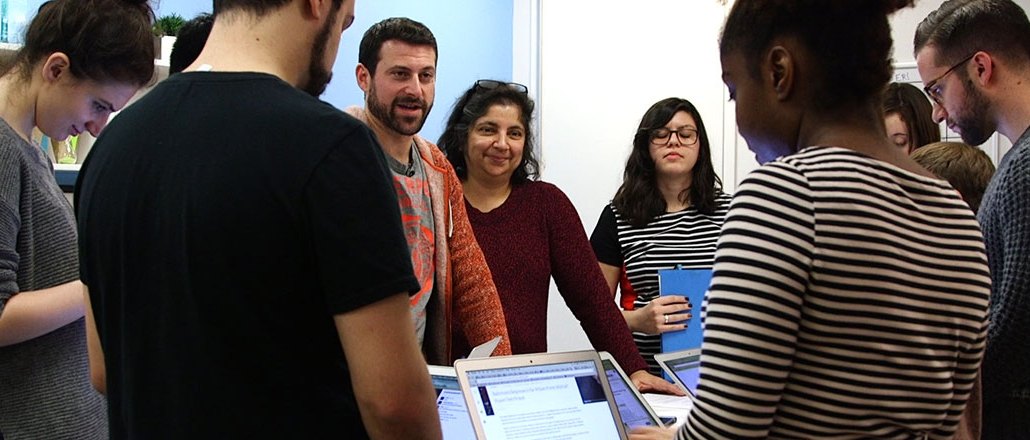
Mic, the millennial-run news outlet that caters to millennials, is looking to conquer Europe. The 5-year-old publisher covers everything from politics to digital culture and has 18 million monthly unique visitors in the U.S., according to comScore. Although brand awareness in the U.K. is not a strong, its content is gaining traction: More than a million of its international unique visitors come from the U.K., despite not yet having a physical editorial presence in the country — something it plans to change.
Speaking to Digiday at the Guardian’s Changing Media Summit, Mic founder and CEO Chris Altchek spoke about how the publisher plans to become a major player on the global stage — and the role video is likely to play.
Here are the takeaways.
Establishing a foothold in Europe
Mic has set its sites on two of Europe’s biggest media markets: Germany and the U.K. In March, Mic inherited a 10-person Berlin-based team following its acquisition of German mobile app Hyper, which mines and aggregates video content from the Web and packages it into a magazine-type format.
“We connected with Hyper six months ago and realized they had built the best video product out there and were targeting a similar audience to ours,” said Altchek. We can help them with their media relationships to make it really big, really fast. We’ll launch a load of new products with them later this year.”
It’s launched one already: Yesterday Hyper launched an app exclusively on Apple TV in the U.S. “Apple TV and other connected TV and smart TV streaming services is a space we’re starting to see a lot of growth in, and we’re very excited about exploring that,” he said.
Mic has two sales people in the U.K., who started at the beginning of the year. There’s no official date on when it will add editorial staff to the mix, because it wants to stay flexible and adjust to any future, potential market curveballs. That said, “It will happen,” insisted Altchek.
Tailoring brand mantra for European markets
The vision for Mic is to be the de facto news brand for “college-educated millennials,” though for Europe it’s working on a different mission statement. “That marker won’t fly in Europe. In the U.S., going to college is a big accomplishment; people aspire to it. Here, that’s seen as a much snobbier thing to say, so we’re working on a different concept,” said Altchek.
One thing the news brand doesn’t want: to be everything to everyone. For Mic, scaling its audience overseas won’t mean losing its editorial focus, which is critical if it’s to continue appealing to its core audience.
“Millennials are an interesting group, because they’ve been consuming the same type of content on Facebook, Tumblr, Twitter and Reddit, for five to 10 years whether they’re in Tokyo, Paris, Rio or New York. So there’s this shared global understanding that allows for a broader set of media brands to be built today than previously.”
A legacy publisher’s domestic dominance, on the other hand, doesn’t necessarily translate on the global stage. The BBC, for example — an institution in the U.K. — faces steep competition internationally. The same goes for CNN in the U.S., said Altchek. “We’re exploring whether we can build a No. 1 player in multiple markets, because there is that shared list of channel, language, culture that would allow us to do that.”
Smart video platform distribution
Six months ago, live video reporting wasn’t a huge talking point at Mic. Facebook’s live video product changed that, and now it’s a priority. In terms of uptick, Altchek is candid that live video reporting is in its early stages, and some do well, while others less so. But it’s all about experimenting to see what sticks. Now that it’s looking into connected TV apps, video output is likely only to increase.
So far it has tested the waters a few times with some live video reporting. Earlier this month, it posted “Live insight from Mic on Super Tuesday,” which got just under 50,000 views, 1,400 comments. Another format is “Sad Desk Lunch” in which Mic reporters discuss the politics of the day over their lunch. This video has had 40,266 views within a few weeks and attracted 1,100 comments, according to Facebook. It’s also been doing more 360-degree video filming, such as this one, where Mic’s editor-at-large and co-founder Jake Horowitz reported on-the-ground in Cuba ahead of President Obama’s inaugural press visit.
Mic’s editorial distribution strategy is all about getting a handle on new platforms that are likely to explode, before the competition, according to Altchek. “We’re built around platforms. When a new one comes around, we very aggressively figure out how to do it better than anyone else.”
More in Media

From sidelines to spotlight: Esports events are putting creators center stage
Esports events’ embrace of content creators reflects advertisers’ changing priorities across both gaming and the wider culture. In the past, marketers viewed esports as one of the best ways to reach gamers. In 2025, brands are instead prioritizing creators in their outreach to audiences across demographics and interest areas, including gaming.

Condé Nast and Hearst strike Amazon AI licensing deals for Rufus
Condé Nast and Hearst have joined the New York Times in signing a licensing deal with Amazon for its AI-powered shopping assistant Rufus.

Media Briefing: AI payouts may be entering a new era
AI compensation is evolving — and new models, not just publisher demands, are driving the shift beyond flat-fee licensing.





